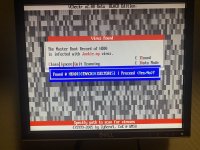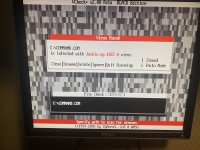Ah, and another thing I just remembered: If you know the normal sound your machine makes while booting, you could tell whether it was infected with ParityBoot or not. Back then, I had an IBM PS/2 machine (386). Normally on power up, after the RAM test ended, it seek-tested the floppy once ("brrrrt"), beeped (POST OK), then tried to boot from the floppy ("brrt") and finally booted from the HD. When the machine was infected, you got two identical drive seek sounds instead of one after the POST beep (ParityBoot becoming active, searching for a floppy to infect). Funny, whenever I heard those two seek sounds instead of one, I knew it was time to get the F-PROT boot disk out again, do an FDISK /MBR and scan my floppies...

. Let me know if you find an ParityBoot infection on this machine, I'd be very surprised if the cause for these errors is something else.



